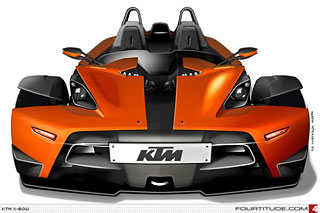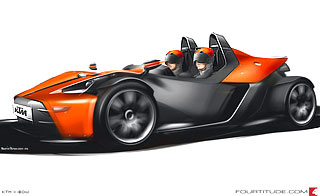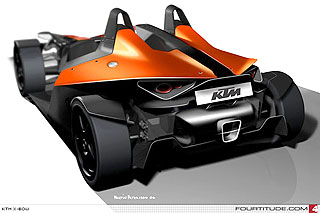KTM X-Bow – 2.0T-Powered Lightweight Sportscar
With this press release, motorcycle manufacturer KTM has revealed details of its plans for a lightweight car. Audi boss Dr. Martin Winterkorn has made mention of this project before, powered by Audi's 2.0T engine. Whether or not Audi will create their own version remains to be seen, though the general consensus among industry insiders is that Ingolstadt will do so. The bridge between motorcycle and car
The bridge between motorcycle and car
- Lightweight carbon fibre chassis
- Four cylinder TFSI from Audi
- Superior driving performance
- Purist, filterless driving experience
- Presentation at the Geneva Motor Show
- Pre-series production start already in 2007
KTM – Europe’s second biggest motorcycle manufacturer – will introduce the first ever car in the company’s 50-year history: the X-Bow. The background for this step can be found in the dynamic development of the company. An annual growth rate of 21 percent in sales and 25 percent in turnover has been achieved since the new start-up of the motorcycle production in the year 1992. The company’s output in 1992 was 6000 motorcycles with 160 employees while in the last financial year production was 84,421 motorcycles with 1697 employees.
Since the beginning of the new century, KTM, as the world market leader in the offroad segment has successively expanded its range of business activities into the street segment. The first step into the automotive sector is therefore a logical extension of this strategy. With the X-Bow, KTM can offer all those who do not have a motorcycle license a driving experience that is typical for the brand.
The Philosophy: Ready to Race
As different as cars and motorcycles may be, KTM has managed to transfer its development principles from two wheels to a sports car in every way. In this way the unique driving experience and the spectacular merits of the drive are not just dependent on the performance of the engine. Just as they have managed to do with motorcycles, the KTM developers have kept the weight of the vehicle extremely light by using the latest materials, an intelligent construction and a purist styling. The car will weigh only about 700 kg.
The interaction between the sophisticated aerodynamic concept and a motor sports-oriented chassis makes the X-Bow clearly superior to a far higher performance sports car. Thanks to its open form of construction, the just 70mm high windshield and the free standing wheels after the style of a Formula racing car, it is not only the appearance, but also the driving experience that is immediately evident as entirely unique.

 Speed from every perspective: the design
Speed from every perspective: the design
Aggressive, edgy, dynamic, a personality from every angle: the design of the KTM X-Bow originates unmistakably from the house of Kiska. Austria’s biggest design studio has had close links to KTM for almost 15 years and is not only responsible for the design of the motorcycles, but also for the corporate image of the company. The design of a lightweight sports car is where passion and challenge meet, resulting in a product that fits seamlessly into the KTM brand family.
The stylish hallmark of the X-Bow is its light-footed, optical presence evoked by the apparent floating panels of the bodywork, the rangy wheels and the transparent area that allows a perspective of the vehicle technology, which for example makes parts of the suspension and damping visible. The technical elegance of the carbon chassis has been used as a design element for the graphic concept. The two outer mirrors which are fixed to double guided stays are symbolic of the lightweight construction.
The purist attitude of the X-Bow also finds its expression in the striking headlights and rear lights. The rear is dominated by a central silencer and a powerful diffuser which is an indication of the level of painstaking work on the aerodynamics of the vehicle.
And as the first ever KTM sports car, the X-Bow naturally comes in the Mattighofen fashion colours: black and orange.
Cooperation with Dallara: The carbon fibre monocoque
The core of the KTM X-Bow is the sophisticated carbon fibre monocoque. This high-tech solution was until now reserved for use in top class motor sport and for elite street sports cars. Through a new construction- and production process developed together with the Italian development partner, the tradition-rich racing car specialist Dallara, this technology can now be offered in a significantly cheaper version. The KTM X-Bow therefore takes on the role of a forerunner that can use new insights and production processes to its benefit.
These advantages are impressive everywhere: With an extremely light weight of around 70 kg, the chassis of the X-Bow offers a maximum amount of rigidity and safety. A crash box in the front nose of the monocoque absorbs collision energy, while the roll bars are integrated into the structure.
An options kit is available on request which increases the recognized safety levels to that of the motor sports authorities FIA: this includes having additional struts mounted at already designated points.
Intelligent Turbo Power
KTM was able to secure Audi AG as a partner for the engine, which when delivered from the company in Ingolstadt Germany, is a congenial extension for the slim concepts of the KTM X-Bow. The four cylinder engine completely made of aluminium is light, compact and includes the most modern engine technology: four valve technology, FSI direct fuel injection, high pressure injection valves, turbo charge, a smooth, adjustable intake camshaft and two balancer shafts.
With this engine, the basic version of the KTM X-Bow will achieve 220 hp. An additional version will have a performance in the area of 300 hp at its disposal. First simulations for the KTM X-Bow in any case demonstrate its superior characteristics; the acceleration to 100kph should be comfortably under four seconds.
The transmission versions also come from Audi AG. A manual six-gear transmission comes with the series production, while an optional DSG-transmission will also be offered.
Motor sports for the highway
Apart from the optimal distribution of weight with the engine mounted between the axles, a guarantee of high speeds in the corners comes from the chassis’ high quality suspension and damping elements. In this area KTM can call upon competence in its own company: the KTM Netherlands subsidiary White Power has at its disposal chassis experts for both on road vehicles and motor sports.
The brakes also come from the best possible source: KTM has had a long-term and fruitful partnership with the Italian specialists Brembo.
And for further improvements in the traction, KTM will offer a limited slip differential for the rear axle. This component part is particularly targeted at drivers who want to engage in certain activities on racing circuits.
Purism without compromise
The lightweight concept also demands some limitations. This is why the X-Bow deliberately does away with many comfort features which, because with their weight and the space need for construction have a negative effect on the performance of the vehicle. These include such features as a sound system and an air conditioner.
On the other hand, because of the X-Bow’s concept, it is not dependent on many weighty elements. Its lightweight makes power steering redundant; the narrow windscreen requires neither windscreen washers nor blowers; the sloping lines of the side of the vehicle and the seat height make it possible to get into the car without having a door; and lastly the carbon chassis together with the four-point safety belt create a safety package that makes airbags unnecessary.
It was also a conscious decision to reject any electronic driving aids. The KTM X-Bow is designed as a piece of high-tech sports equipment for experienced customers who prefer a filter less driving pleasure.
Innovative accessories
By doing away with the roof, both the driver and passenger of the KTM X-Bow are exposed to the elements in a similar way to that of a motorcycle. For this reason a decision was taken concerning an accessories program that has parallels with the world of motorcycles.
Special overalls for use with the KTM X-Bow have been developed together with the northern Italian clothing experts Dainese. These garments will take over some of the comfort functions that are usually available with a vehicle with a roof – for example entertainment and communication systems. These functions are directly integrated into the clothing, which will also naturally serve as protection against cold and windy weather.
An important part of the custom-made driver equipment will be a helmet specially designed for this project. Wearing of the helmet is not required by law but is recommended by KTM. In this way the X-Bow also represents a bridge to a motorcycle. Special storage space is also provided for these two helmets.
A light, easy to install tarpaulin to cover the interior of the car will also be available.
Premiere in Geneva
This lightweight sports car with innovative technology will make its first public appearance at the Geneva Motor Show in March 2007. In the same year, 100 units of the comprehensive pre-series will be manufactured in-house by Italian racing car specialists
Dallara and sold by KTM. The price for the basic version will be around EURO 40,000.
Dependent on the reaction to the presentation of the car and the success of the preseries, KTM plans further small series productions of this car. This production will take place in Austria and begin in the year 2008. KTM is working on the basis of a projected 500 units per year for this small series production.
The decision concerning this small series production will be taken at the end of April 2007.
If it is positive, KTM will establish a small but efficient sales structure up to the time of the commencement of production at the end of 2008. It is planned to have a dealer network of up to two qualified sales establishments per country. Where these will be located depends, not the least on the planned European-wide conformity for the norms of small series homologation. According to the present situation, sales offices for the X-Bow could be considered for the following countries: Germany, Finland, Greece, Britain, Netherlands, Austria, Portugal and Switzerland.
© Source: article on fourtitude.com